A Study on the Productivity of Ultra-Deep Carbonate Reservoir (UDCR) Oil Wells Considering Creep and Stress Sensitivity Effects
Abstract
1. Introduction
2. The Model of Matrix–Fracture Coupling Seepage
2.1. Basic Assumptions
- (1)
- The ultra-deep carbonate reservoir is an isothermal seepage system, and the temperature remains constant during the oil well production process;
- (2)
- The seepage of the reservoir is a single-phase micro-compressible fluid, and the seepage in the reservoir follows Darcy’s law;
- (3)
- The reservoir is a cracked carbonate rock, and the creep and stress sensitivity of the matrix and natural fractures are not considered;
- (4)
- Both the matrix and the fracture are continuous medium and are isotropic;
- (5)
- This is a two-dimensional seepage model, and the influence of gravity is not considered.
2.2. Mathematical Model
- (1)
- Acid-etched Fracture conductivity reduction Model
- (2)
- Acid-etched Fracture deformation Model
- (3)
- Matrix Seepage Equation
- (4)
- Natural-Fracture Seepage Equation
- (5)
- Acid-etched fracture Seepage Equation
- (6)
- Boundary and Initial Conditions
2.3. Model Solution
2.4. Model Validation
3. Sensitivity Analysis of Influence Factors
3.1. Effect of Stress Sensitivity on Well Productivity
3.2. Effect of Creep on Well Productivity
3.3. Effect of Other Factors on Well Productivity
- (1)
- Effect of Initial Pressure
- (2)
- Effect of Drawdown Pressure
- (3)
- Effect of Production System
- (4)
- Effect of Management Time
4. Conclusions
- This study successfully constructed a numerical model of a UDCR oil well that considers creep and stress sensitivity. This model can more accurately describe the coupling mechanism between rock mechanical characteristics and seepage characteristics during oil well production. When traditional models ignore the coupling effect between the two, the oil well productivity is overestimated.
- The creep and stress sensitivity characteristics of rocks have a significant impact on the production capacity of UDCR oil wells. The greater the creep coefficient and stress-sensitive coefficient, the lower the oil well productivity. The greater the initial reservoir pressure and drawdown pressure, the higher the daily production and cumulative production of the oil wells. However, at the same time, the greater initial reservoir pressure and drawdown pressure will enhance stress sensitivity and creep, resulting in a decrease in permeability, thereby reducing the cumulative production growth.
- The cumulative production in the early stage of pressure-release production is significantly higher than that in pressure-controlled production. However, as the pressure-control time increases, production reversal occurs. When the pressure-control duration reaches three years, the cumulative production increases by 5952 m3 (38.8%). As the creep coefficient increases, the increase in cumulative production for pressure-controlled production compared to pressure-release production becomes more significant. This indicates that the larger the creep coefficient, the better the effect of pressure-control production. In other words, the larger the creep coefficient, the more beneficial pressure-control production becomes.
- During the development of UDCR, the effects of creep and stress sensitivity should be fully considered. The production system should be optimized, and the production pressure should be reasonably controlled to enhance the EUR of UDCR oil wells and improve the overall development efficiency of the reservoir.
Author Contributions
Funding
Data Availability Statement
Conflicts of Interest
References
- Yi, H.Y.; Zhang, B.J.; Gu, M.F.; Ma, H.L.; Zhang, X.H.; Chen, X.; Xie, C.; Gao, Z.L.; Shan, S.J.; Zhu, K.D. Discovery of isolated shoals in the Permian Maokou Formation of eastern Sichuan Basin and their natural gas exploration potential. Nat. Gas Ind. 2024, 44, 1–11. [Google Scholar]
- Qu, Z.; Lin, Q.; Guo, T. Experimental study on acid fracture conductivity of carbonate rock in Shunbei Oilfield. Fault-Block Oil Gas Field 2019, 26, 533–536. [Google Scholar]
- Qi, N.; Ma, T.; Zhang, Z.; Liu, X.; Liu, L. Creep closure mechanism of acid-etched fractures in limestone. Nat. Gas Ind. 2024, 44, 73–82. [Google Scholar]
- Han, X. Study on Mechanical Characteristics and Conductivity of Acid Etch Soften Layer in Limestone. Ph.D. Thesis, Chengdu University of Technology, Chengdu, China, 2018. [Google Scholar]
- Xiao, Y.; Wang, H.; Mi, Z.; Cheng, Y.; Cao, X.; Qu, J.; Guo, J. Laboratory measurements of acid-etched fracture conductivity for medium-high porosity and low permeability limestone reservoirs in EE oil field. In Proceedings of the 54th U.S. Rock Mechanics/Geomechanics Symposium, Golden, CO, USA, 28 June–1 July 2020; p. ARMA-2020-1394. [Google Scholar]
- Yao, S.; Wang, X.; Yuan, Q.; Zeng, F. Transient-Rate Analysis of Stress-Sensitive Hydraulic Fractures: Considering the Geomechanical Effect in Anisotropic Shale. SPE Reserv. Eval. Eng. 2018, 21, 863–888. [Google Scholar] [CrossRef]
- Wang, J.; Luo, W.; Chen, Z. An integrated approach to optimize bottomhole-pressure-drawdown management for a hydraulically fractured well using a transient inflow performance relationship. SPE Reserv. Eval. Eng. 2020, 23, 95–111. [Google Scholar] [CrossRef]
- An, C.; Killough, J.; Xia, X. Investigating the effects of stress creep and effective stress coefficient on stress-dependent permeability measurements of shale rock. J. Pet. Sci. Eng. 2020, 198, 108155. [Google Scholar] [CrossRef]
- Zhou, J. Study on the Conductivity of Acid Etching Fractures in Low Young’s Modulus Carbonate Rocks. Master’s Thesis, Institute of Porous Flow & Fluid Mechanics, China National Petroleum Corporation & Chinese Academy of Science, Langfang, China, 2021. [Google Scholar]
- Li, D.; Li, H.; Zhu, S. Study of permeability stress sensitivity of large-scale discrete fracture: A case study of Shunbei Oil Field. Fault-Block Oil Gas Field 2024, 31, 147–153. [Google Scholar]
- Zhou, B. Study on Stress Sensitivity of Long-Term Acid Fracture Conductivity in Carbonate Reservoirs. Master’s Thesis, China University of Petroleum (Beijing), Beijing, China, 2019. [Google Scholar]
- Teng, B.; Li, H.; Yu, H. A Novel Analytical Fracture-Permeability Model Dependent on Both Fracture Width and Proppant-Pack Properties. SPE J. 2020, 25, 3031–3050. [Google Scholar] [CrossRef]
- Teng, B.; Luo, W.; Chen, Z.; Kang, B.; Chen, L.; Wang, T. A comprehensive study of the effect of Brinkman flow on the performance of hydraulically fractured wells. J. Pet. Sci. Eng. 2022, 213, 110355. [Google Scholar] [CrossRef]
- Pang, Y.; Soliman, M.Y.; Deng, H.; Emadi, H. Analysis of Effective Porosity and Effective Permeability in Shale-Gas Reservoirs with Consideration of Gas Adsorption and Stress Effects. SPE J. 2017, 22, 1739–1759. [Google Scholar] [CrossRef]
- Mirani, A.; Marongiu-Porcu, M.; Wang, H.; Enkababian, P. Production-Pressure-Drawdown Management for Fractured Horizontal Wells in Shale-Gas Formations. SPE Reserv. Eval. Eng. 2018, 21, 550–565. [Google Scholar] [CrossRef]
- Zhang, T.; Guo, J.; Zeng, J.; Zhang, H.; Zhao, Z.; Zeng, F.; Wang, W. A transient source-function-based embedded discrete fracture model for simulation of multiscale-fractured reservoir: Application in coalbed methane extraction. Gas Sci. Eng. 2025, 133, 205500. [Google Scholar] [CrossRef]
- Zhou, H.W.; Wang, L.J.; Rong, T.L.; Zhang, L.; Ren, W.G.; Su, T. Creep-based permeability evolution in deep coal under unloading confining pressure. J. Nat. Gas Sci. Eng. 2019, 65, 185–196. [Google Scholar] [CrossRef]
- Zhou, H.W.; Zhang, L.; Wang, X.Y.; Rong, T.L.; Wang, L.J. Effects of matrix fracture interaction and creep deformation on permeability evolution of deep coal. Int. J. Rock Mech. Min. Sci. 2020, 127, 104236. [Google Scholar] [CrossRef]
- Cui, Y.; Lu, C.; Guan, Z.; Luo, W.; Teng, B.; Meng, F.; Peng, Y. Effects of creep on depressurization-induced gas well productivity in South China Sea natural gas hydrate reservoirs. Pet. Reserv. Eval. Dev. 2023, 13, 809–818. [Google Scholar]
- Chen, H. Study on Creep Mechanical Behavior and Creep Model of Fractured Rock Under Stress-Seepage Coupling Conditions. Master’s Thesis, Xihua University, Chengdu, China, 2023. [Google Scholar]
- Du, X.; Cheng, L.; Niu, L.; Chen, Y.; Cao, R.; Xie, Y. Numerical Simulation of 3D Discrete Fracture Networks Considering Dynamic Closure of Hydraulic Fractures and Natural Fractures. Chin. J. Comput. Phys. 2022, 39, 453–464. [Google Scholar]
- Tang, J.; Teng, J.; Zhang, C.; Liu, S. Experimental study of creep characteristics of layered water bearing shale. Rock Soil Mech. 2018, 39 (Suppl. S1), 33–41. [Google Scholar]
- Feng, J.; Sun, Z.; Wang, Y.; She, J. Study on Stress Sensitivity of or dovician Fractures in Hetianhe Gas Field, Tarim Basin. Geol. J. China Univ. 2019, 25, 276–286. [Google Scholar]
- Zhao, J. Study on Pore-Elastic Viscoplasticity Mechanical Properties of Shale and Its Influence on Conductivity of Artificial Fracture. Master’s Thesis, China University of Petroleum (Beijing), Beijing, China, 2023. [Google Scholar]
- Liu, W. Stress and Time Effects of Fractured Sandstone Permeability. Master’s Thesis, Shijiazhuang Tiedao University, Shijiazhuang, China, 2022. [Google Scholar]
- Rang, T. Research on Fracture Deformation Mechanism and Numerical Simulation Methods of Shale Oil Reservoir. Master’s Thesis, China University of Petroleum (Beijing), Beijing, China, 2023. [Google Scholar]
- Guo, W.; Liu, J.; Zhang, X.; Teng, B.; Kang, L.; Gao, J.; Liu, Y.; Luo, W. Study on the mechanism ofdrawdown management of shale gas horizontal well considering creep effect. Chin. J. Theor. Appl. Mech. 2023, 55, 630–642. [Google Scholar]
- Warren, J.E.; Root, P.J. The behavior of naturally fracture reservoirs. Soc. Pet. Eng. J. 1963, 228, 245–255. [Google Scholar] [CrossRef]
- Moinfar, A.; Varavei, A.; Sepehrnoori, K.; Johns, R.T. Development of a coupled dual continuum and discrete fracture model for the simulation of unconventional reservoirs. In Proceedings of the SPE Reservoir Simulation Symposium, The Woodlands, TX, USA, 18–20 February 2013; p. SPE-163647-MS. [Google Scholar]
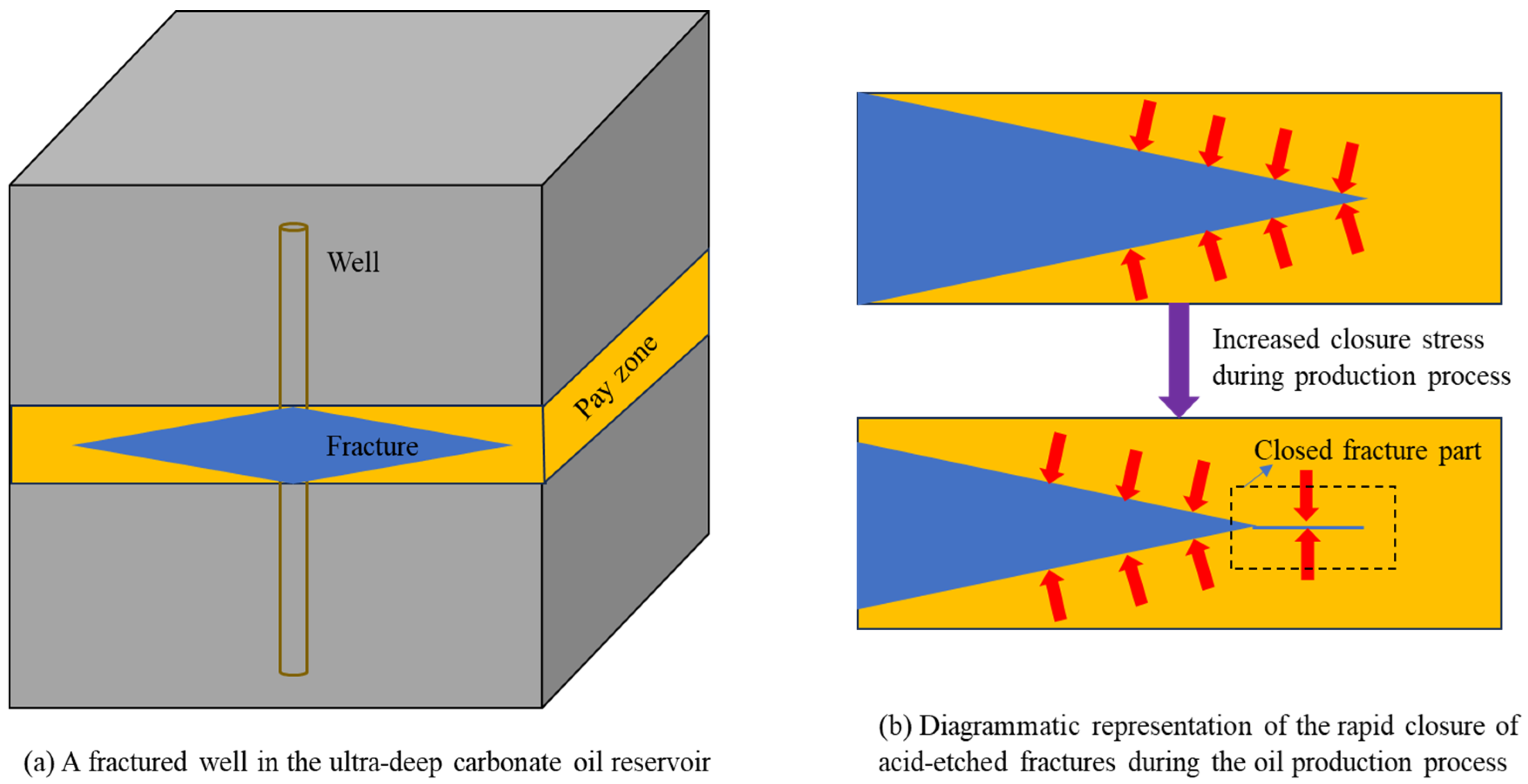
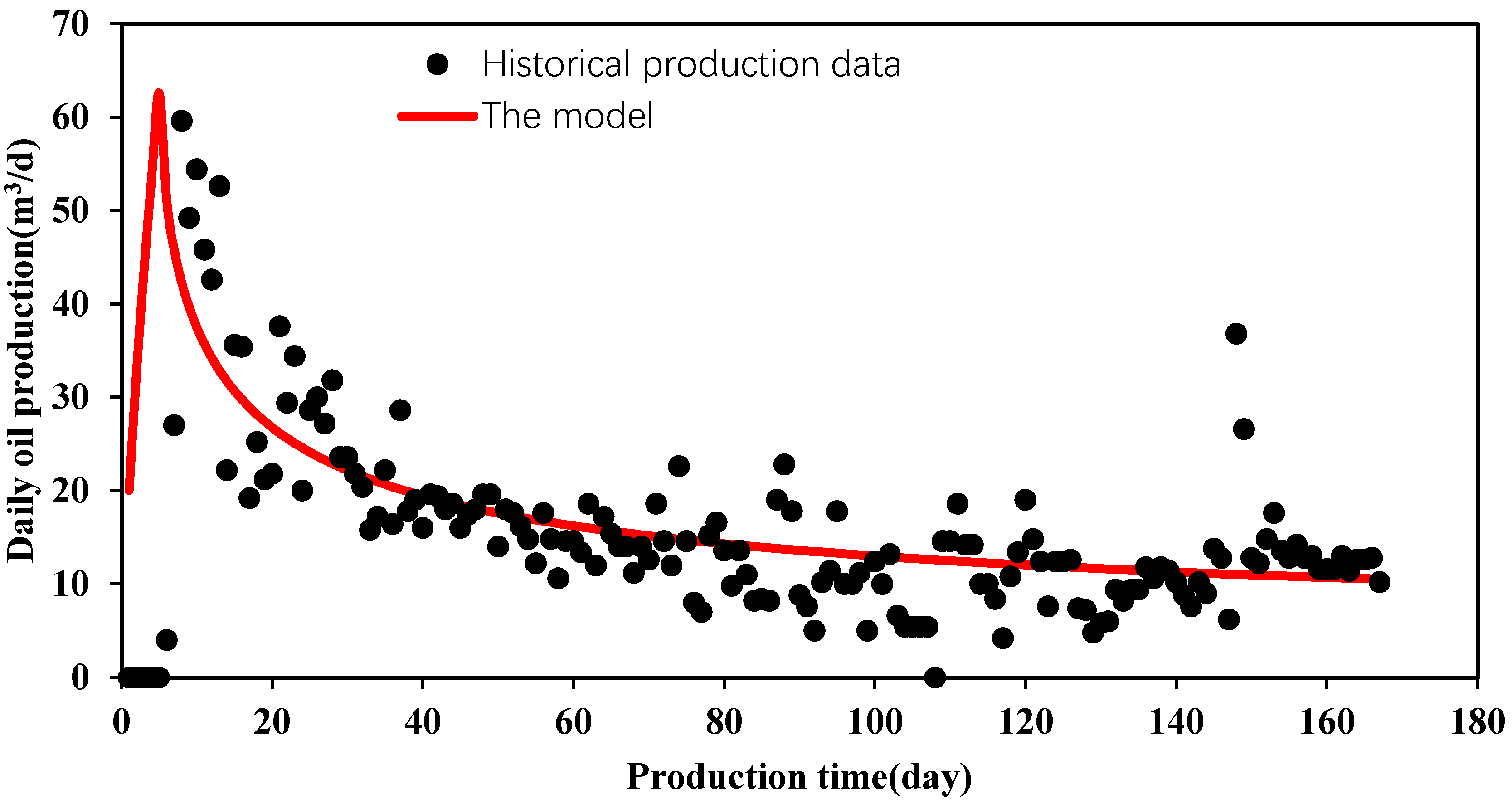

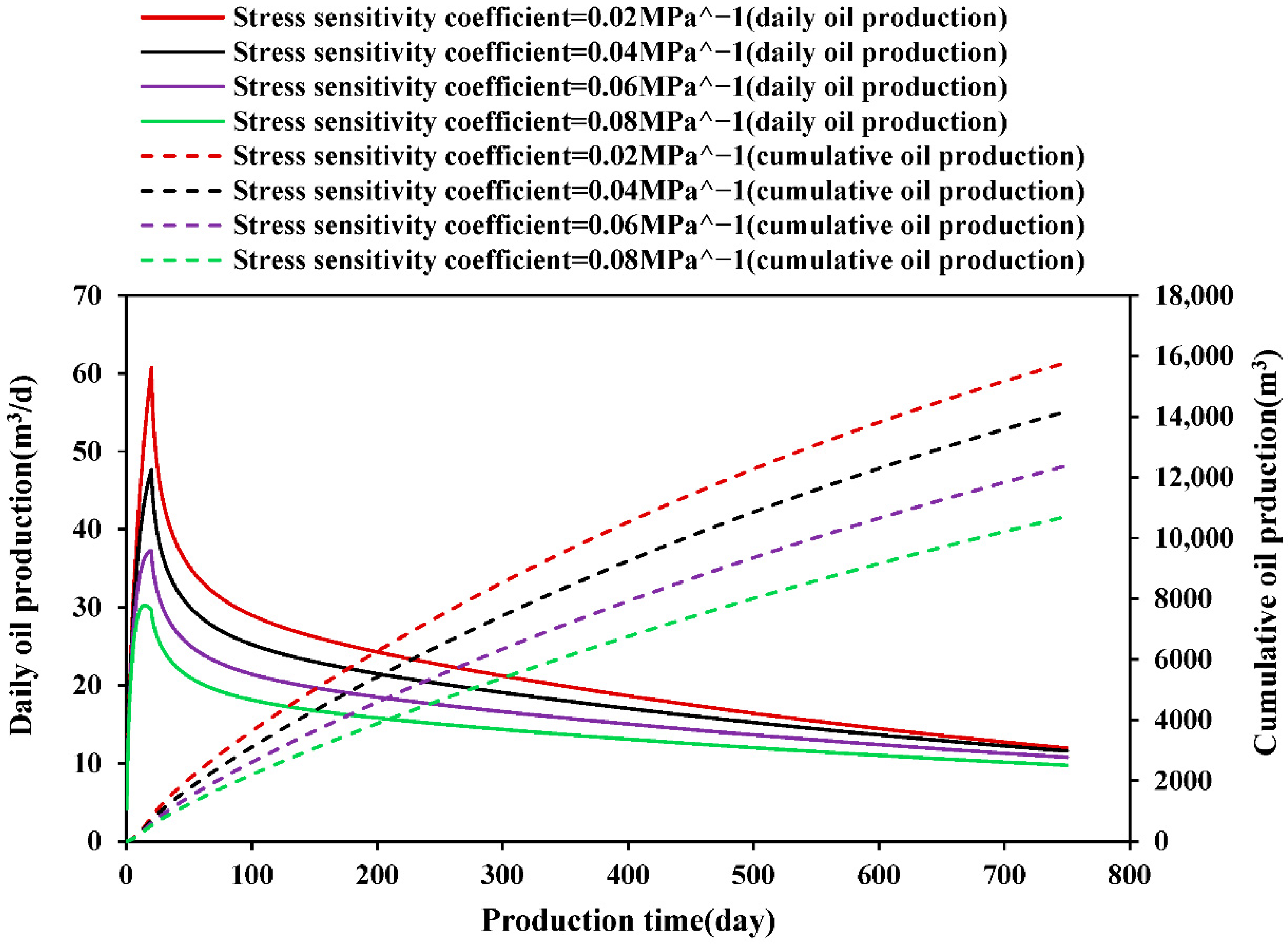
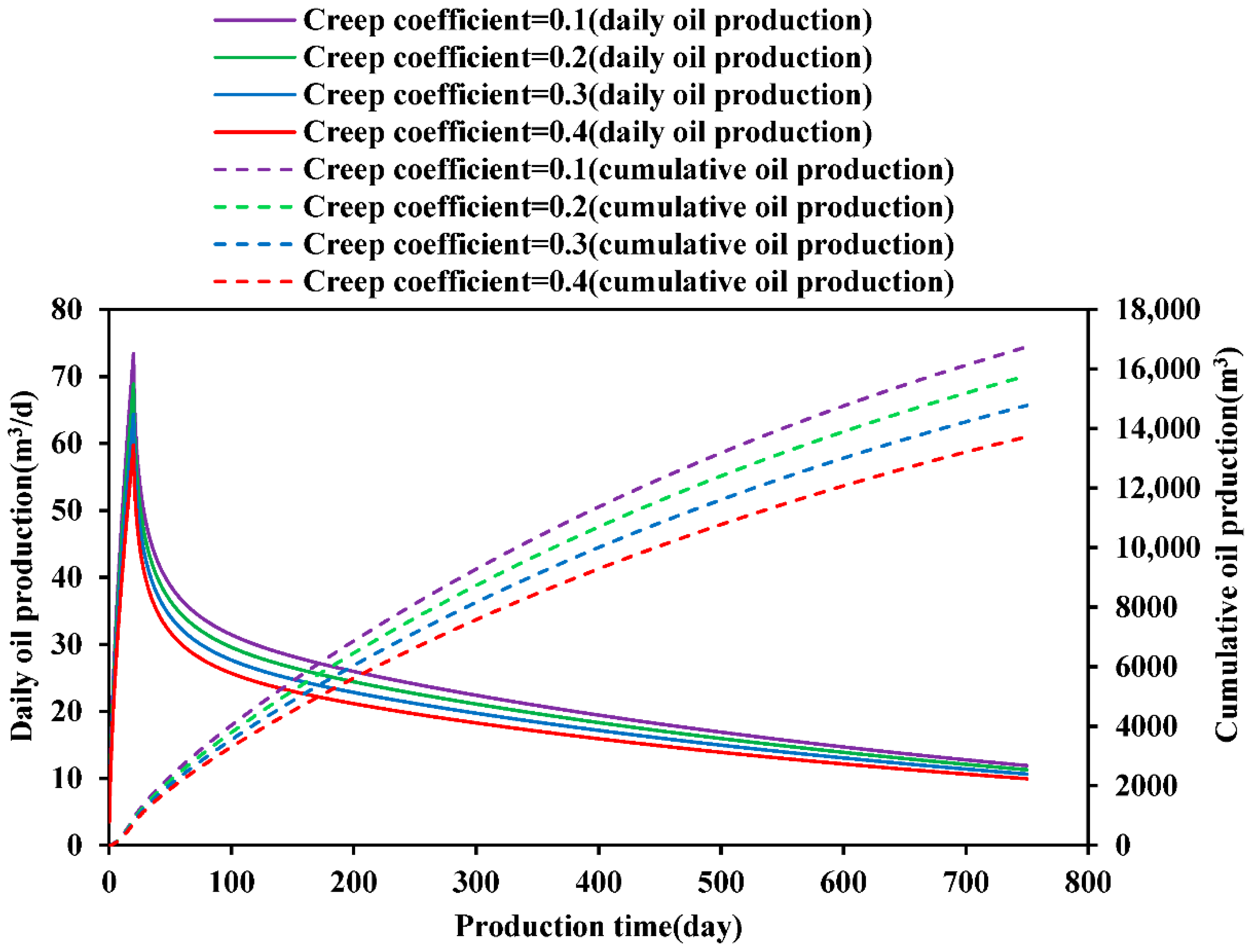
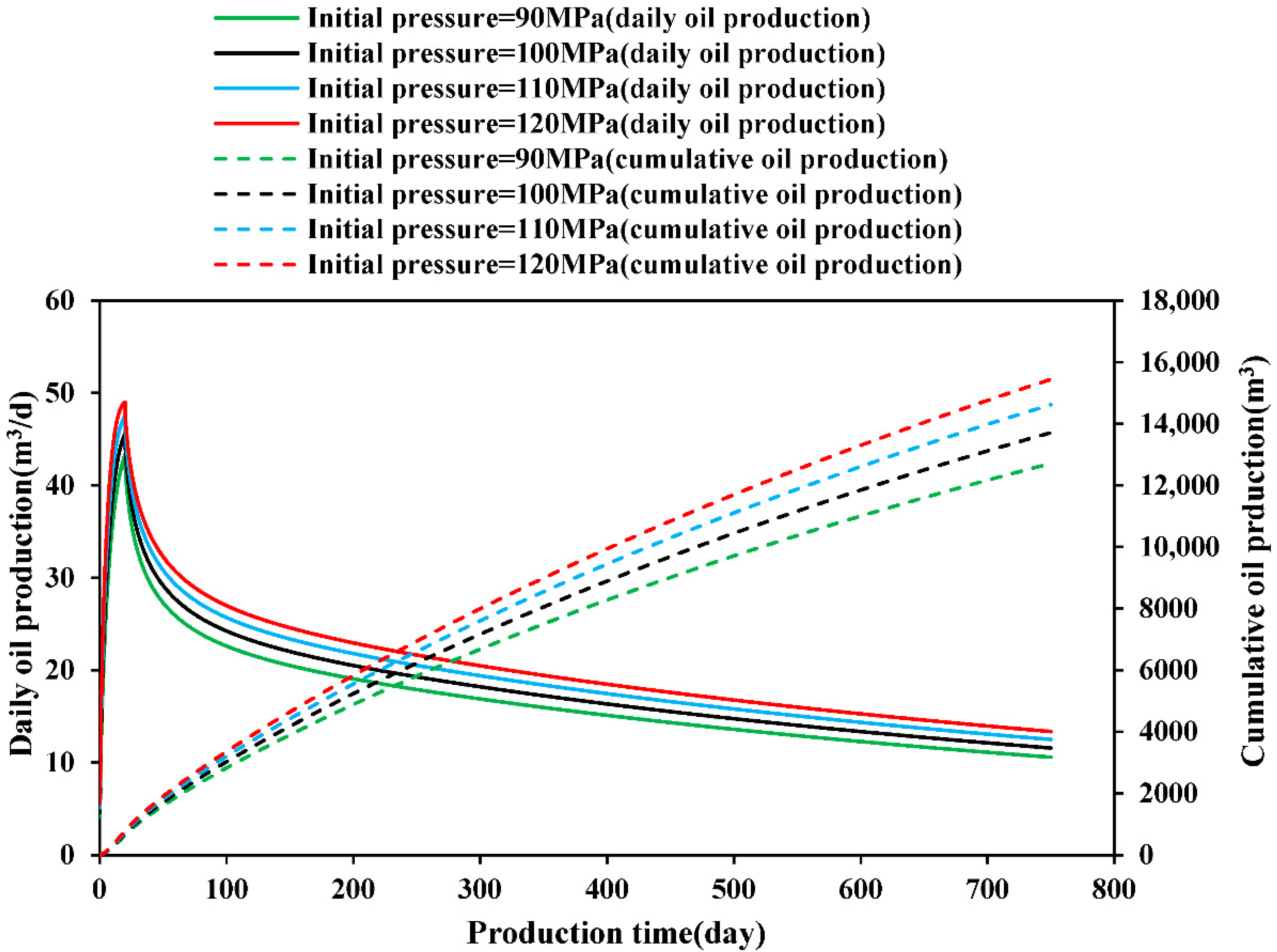

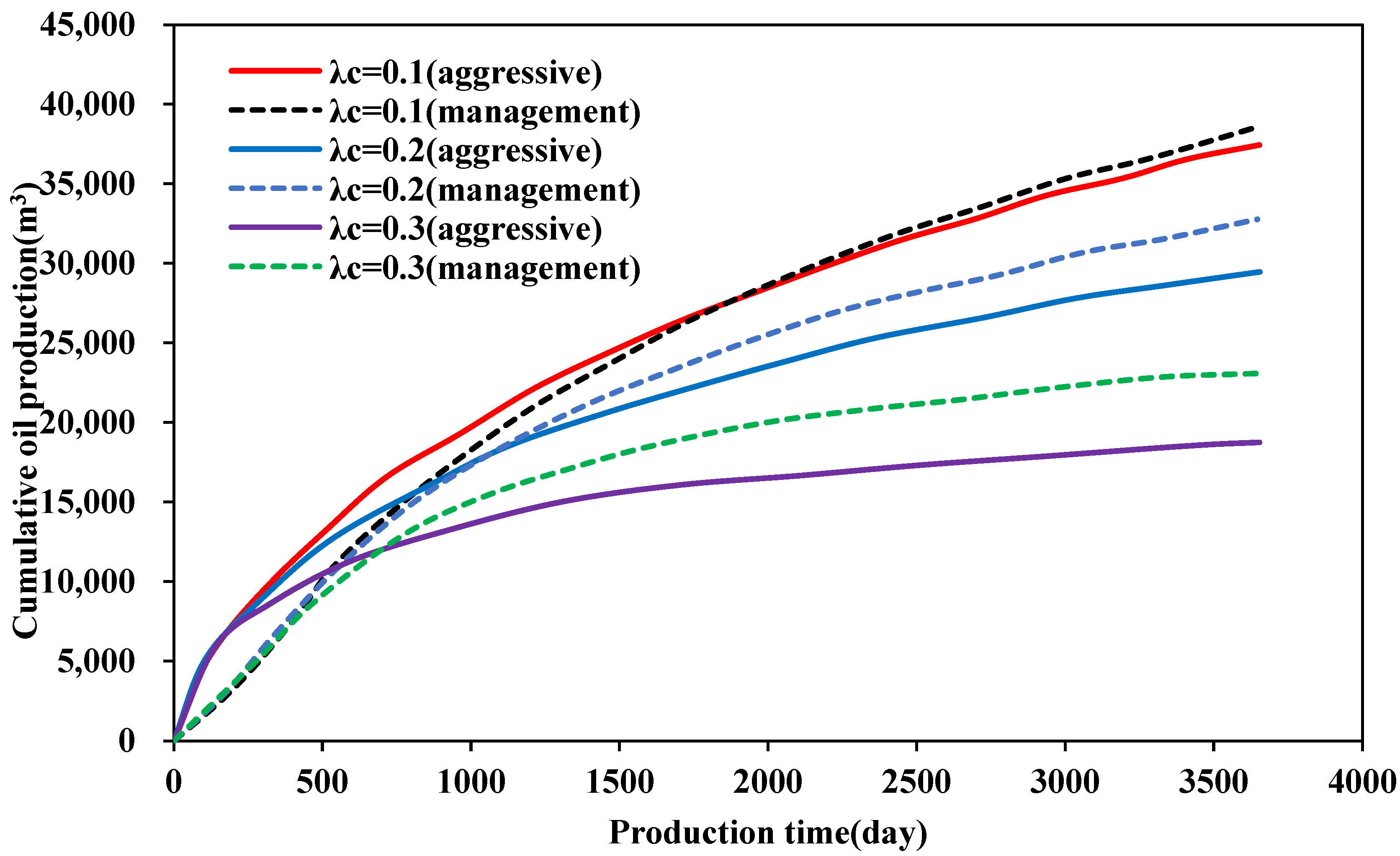
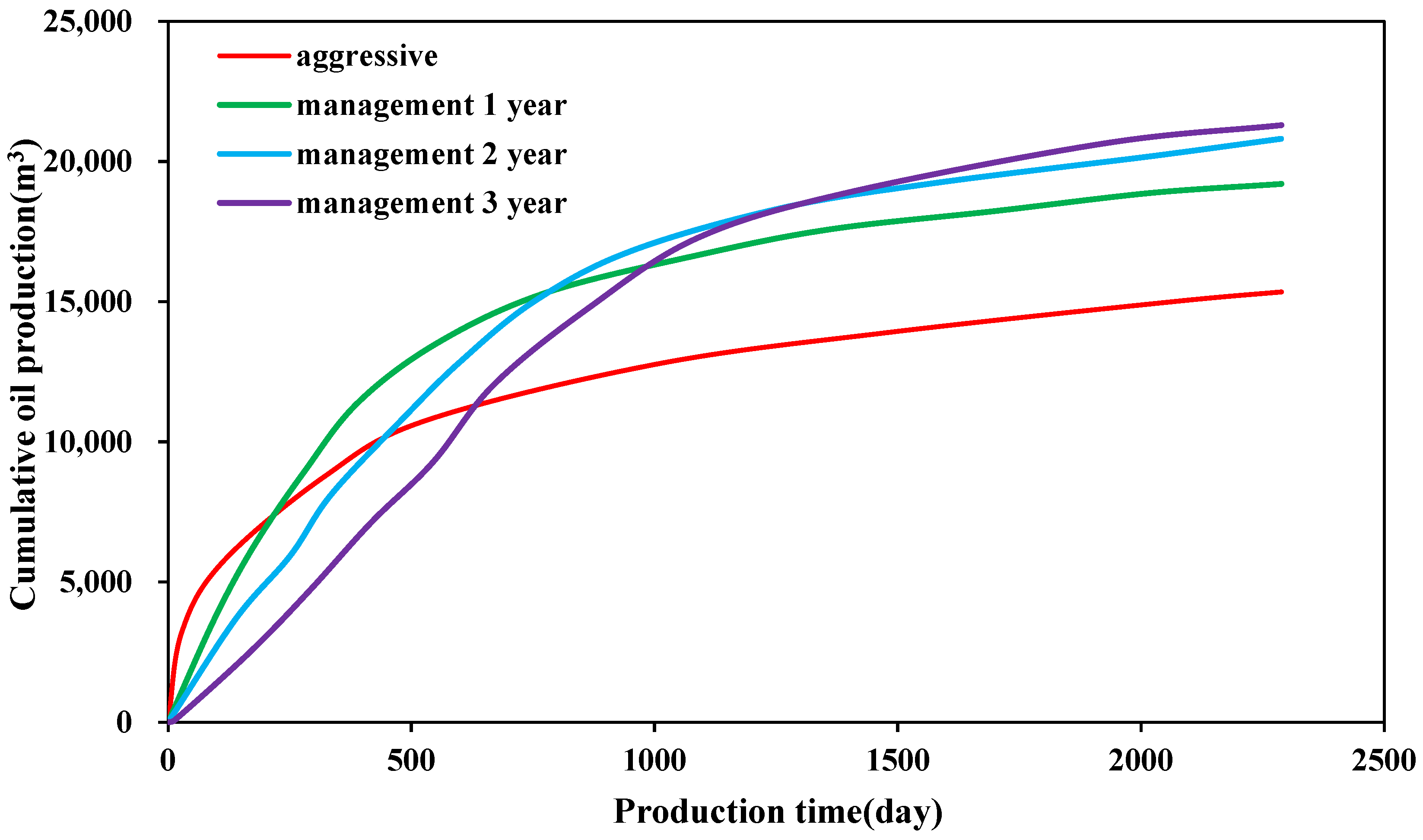
| Parameter | Value | Unit | Parameter | Value | Unit |
|---|---|---|---|---|---|
| Initial pressure | 90 | MPa | Oil saturation | 60 | % |
| Reservoir temperature | 200 | °C | Well radius | 0.1 | m |
| Matrix porosity | 2.1 | % | Oil viscosity | 10 | mPa·s |
| Natural-fracture porosity | 1.2 | % | Fracture length | 80 | m |
| Matrix permeability | 0.5 | mD | Fracture height | 30 | m |
| Natural-fracture permeability | 10 | mD | Initial fracture conductivity | 15 | D·cm |
Disclaimer/Publisher’s Note: The statements, opinions and data contained in all publications are solely those of the individual author(s) and contributor(s) and not of MDPI and/or the editor(s). MDPI and/or the editor(s) disclaim responsibility for any injury to people or property resulting from any ideas, methods, instructions or products referred to in the content. |
© 2025 by the authors. Licensee MDPI, Basel, Switzerland. This article is an open access article distributed under the terms and conditions of the Creative Commons Attribution (CC BY) license (https://creativecommons.org/licenses/by/4.0/).
Share and Cite
Li, Z.; Sun, L.; Huang, B.; Luo, S. A Study on the Productivity of Ultra-Deep Carbonate Reservoir (UDCR) Oil Wells Considering Creep and Stress Sensitivity Effects. Processes 2025, 13, 2165. https://doi.org/10.3390/pr13072165
Li Z, Sun L, Huang B, Luo S. A Study on the Productivity of Ultra-Deep Carbonate Reservoir (UDCR) Oil Wells Considering Creep and Stress Sensitivity Effects. Processes. 2025; 13(7):2165. https://doi.org/10.3390/pr13072165
Chicago/Turabian StyleLi, Zhiqiang, Linghui Sun, Boling Huang, and Shishu Luo. 2025. "A Study on the Productivity of Ultra-Deep Carbonate Reservoir (UDCR) Oil Wells Considering Creep and Stress Sensitivity Effects" Processes 13, no. 7: 2165. https://doi.org/10.3390/pr13072165
APA StyleLi, Z., Sun, L., Huang, B., & Luo, S. (2025). A Study on the Productivity of Ultra-Deep Carbonate Reservoir (UDCR) Oil Wells Considering Creep and Stress Sensitivity Effects. Processes, 13(7), 2165. https://doi.org/10.3390/pr13072165





